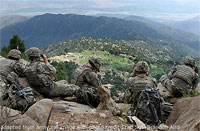Russian Afghan veterans warn NATO against mistakes in pullout from Afghanistan

(Interfax – April 25, 2013) The Russian Union of Afghan War Veterans that unites many generals and officers who took part in the pullout of the Soviet limited contingent from Afghanistan are ready to respond to requests from NATO colleagues and share their materials, Union leader Frants Klintsevich told Interfax-AVN on Thursday.
“I have learned about the NATO request from the media, but I do not rule out it may be made. If that is necessary, my comrades-in-arms and I are ready to share with North Atlantic Alliance partners our analysis and recollections of the final stage of the Soviet forces on the Afghan land in 1989,” said Klintsevich, Deputy Chairman of the State Duma Defense Committee.
The media said NATO had asked the Russian military to share materials regarding the Soviet pullout from Afghanistan in 1989 before withdrawing the International Security Assistance Force (ISAF) due in 2014.
The expert said there was a big difference between the pullout of the 40th army of the Soviet Armed Forces from Afghanistan and the pending withdrawal of the international coalition forces.
“More than 20 years ago our limited contingent was leaving Afghanistan in strict compliance with the Geneva accords. In spite of that, the Untied States and Pakistan were mounting assistance to the insurgents and we were leaving under the permanent threat of attacks on our columns and under fire. I remember that military operation well because our 345th separate airborne regiment was protecting the Soviet withdrawal from Afghanistan,” Klintsevich stressed.
He thinks that the U.S. administration is repeating some mistakes of former Soviet leaders.
“For instance, there is a decision of the United States and Germany to keep some of their military specialists in Afghanistan after the pullout of the multinational forces from that country in 2014,” he said.
“If the coalition forces are unable to control the situation in Afghanistan in the presence of more than 100,000 servicemen and a huge number of aircraft, it is not difficult to guess what will happen when the Americans and the Germans stay in that country after the pullout of the main ISAF forces. They can hide behind reinforced walls at best; but there will be no question of assistance to Afghan forces,” Klintsevich said.
At the final stage of the withdrawal of the Soviet limited contingent from Afghanistan, “the Soviet administration under the pressure of President Najibullah tried to keep about 30,000 volunteers in that country to protect a road across the Salang Pass, on which the Afghan regime was supplied with armaments and food,” the expert said.
“The volunteers were promised big money, almost ten times more than they were paid in the 40th army,” he added. “Yet a detailed analysis of the situation showed that small forces were unable to withstand the situation in the country with the state of guerrilla warfare and there were no security guarantees. So, the attempt to leave behind volunteers appeared to be a pipe dream of Afghan leaders.”
The media reported the signing of a strategic partnership agreement between U.S. and Afghan administrations concerning bilateral relations after the U.S. pullout from Afghanistan in 2014. The agreement provides the possibility to keep U.S. bases in Afghanistan after the ISAF leaves.
